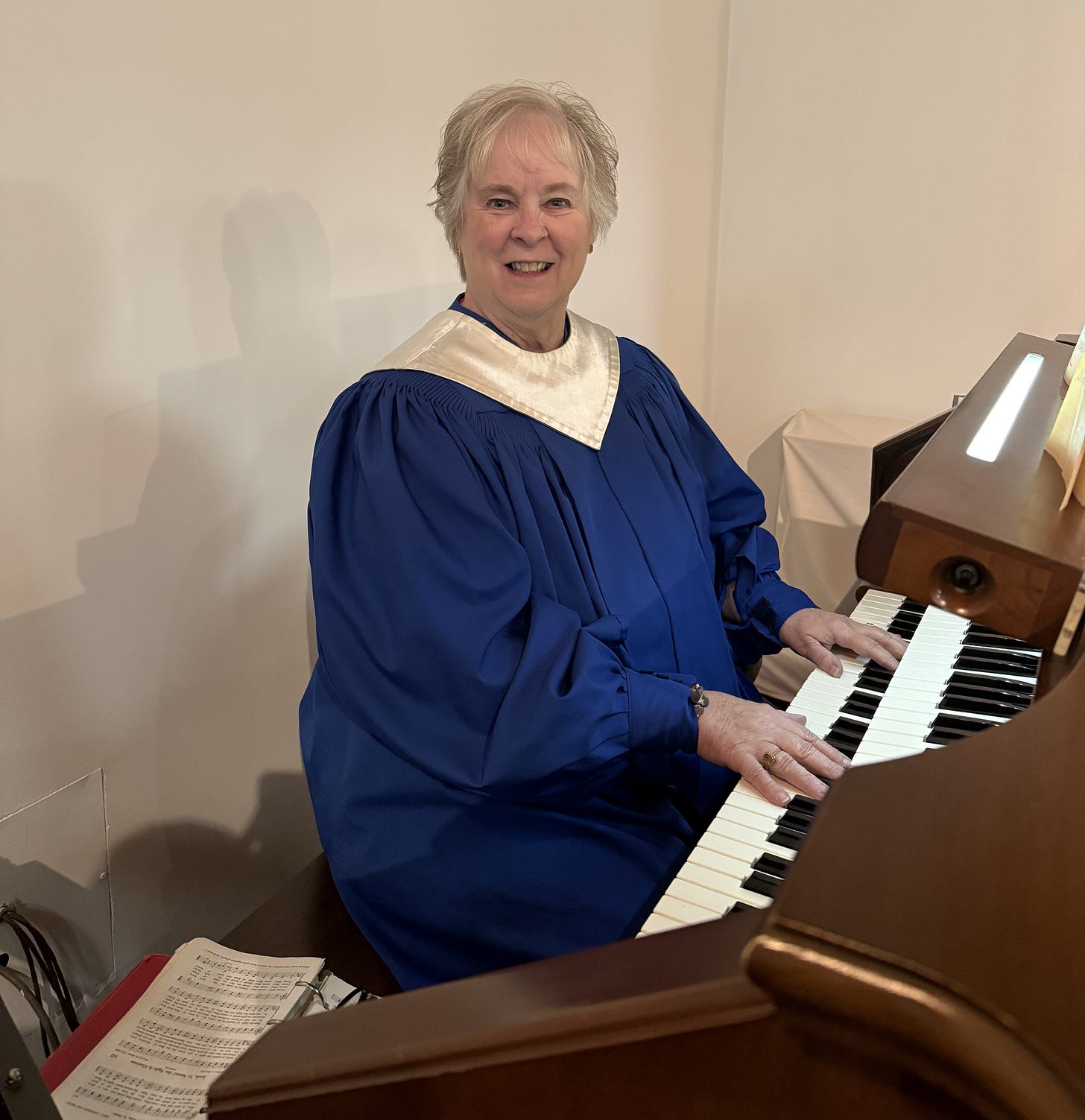ADDISON TIMES MAJOR SPONSOR: STEPHENSON RIFE ATTORNEYS
Organist Marks 50 Years at Evangelical United Church
Eleanor Columbe is celebrating 50 years as organist at Evangelical United Church of in Shelbyville. The daughter of Robert and Virginia Waltz, Columbe is a life-long member of the church. Her grandparents, who immigrated from Germany to Indiana, were charter members of the original church, which was then called Evangelical and Reformed. Eleanor attended Indiana Central College, where she took organ lessons. When she was a junior in college, she accepted the job of organist, and commuted to Shelbyville on weekends to be able to play. Her first Sunday was May 18, 1975. After graduating from Indiana Central, Eleanor taught at Southwestern for 38 years in first and third grade. Eleanor not only plays the organ and piano, she currently serves as choir director and as a member of the church council. She is married to Joe S. Columbe, and they have one son, Mitchell. | submitted
Early Transportation in Central Indiana, Part II
The Fairland Historical Society last week hosted a lecture of interest given by Nancy VanArendonk, president of the Franklin Township Historical Society who was wearing earrings made of original interurban tokens, on Early Transportation in Central Indiana. The following are excerpts from VanAredonk’s presentation. (Part I was published yesterday.)
The March 31, 1903, issue of the Indianapolis News reported that the Indianapolis-Shelbyville and Southeastern interurban company had served notice on the people of Fairland that it was going to cut a new right-of-way paralleling the Big Four railroad tracks through the center of town. People protested the new route, and the company ended up cutting off a corner of the hotel building to run the track and knocked down several buildings.
Charles L. Henry headed up the interurban efforts. He walked most of the 40-mile proposed track from Indianapolis to Rushville so that he could assess the construction challenges. He bought the unbuilt Rushville line and combined it with the Shelbyville line to form the Indianapolis and Cincinnati Traction Company. The I&C only made it to Greensburg, though, partly due to the fact that interurbans had reached their peak.
In the 1920s, the interurban trains ran every hour on major routes, which would have been incredibly convenient, but the 1930s were hard on transit systems. Not only was it the Great Depression, and people just didn't have as much money, but the routes became unprofitable due to rising competition from automobiles and motor coaches.
The last interurban car in Indianapolis was scrapped in January 1953, and track removal began.
Reminders of the interurban’s presence are on the south side of Indianapolis with Stop 10, Stop 11, Stop 12, etc., which designed the interurban stops.
We look back on Detroit as a center of auto manufacturing. But, in the first decades of the 20th century, there were more than 250 automobile manufacturers operating in Indiana.
The crash of 1929 and the resulting depression pretty much destroyed the automobile manufacturing boom in Central Indiana.
ADDISON TIMES MAJOR SPONSOR: FULL CANOPY REAL ESTATE
NOTEBOOK:
HOOSIER NEWS: Hoosier parents had a new favorite baby name for boys in 2024, according to data released this week by the U.S. Social Security Administration. Oliver replaced Liam in the No. 1 spot for baby boys in Indiana, while Charlotte continued its run of popularity topping the state list for the fourth consecutive year. Liam and Oliver have been in the top two spots in some order for Hoosiers every year since 2016. Liam and Olivia were the most popular names nationally. (IndyStar)
NATIONAL NEWS: Researchers at the University of South Florida Optical Oceanography Lab are projecting a massive year for seaweed on the Florida coast, estimating that there will be 40 percent more seaweed than the current record year of 2022. Though the mass of sargassum — measured at 30 million metric tons, based on satellite imagery — may not all careen into the Florida coast, the lab is trying to get better at predicting whether it would hit the coast. It’s an expensive question: beaches are big money in South Florida, and municipalities spend millions of dollars to remove seaweed from their beaches. Miami-Dade County even dropped $2.8 million on seaweed removal in that record 2022 year. (Miami Herald/Numlock)
The Addison Times is pleased to offer free milestone announcements. Forms are available here: Engagement Announcement, Wedding Announcement and Anniversary Announcement.
Want the daily edition read to you? Struggling with your email provider filtering out your local news? The Addison Times Substack app will solve those challenges!
SHS Courier Archive Highlights
March 27, 1931
Lorenzo Linville was named winner of the Paul Cross medal, presented by Rev. S.J. Cross. “Mr. Cross awards this medal every year in honor of his son, Paul, who was the first student of Shelby High to enlist in the World War.”
The Courier published an article on lockers. “Rosalind McKenney keeps hers in perfect order. However, most of the boys must barely open the doors and peek in to see if it is possible to open them wide enough to get a book without having the others fall out on the floor.” Freshmen and sophomore girls had taken possession of a group of lockers in the shower room as a wardrobe for their gym suits. Bob Kunkle left his books on top of his locker to save time. “The locks which were rented to the students by the high school are many times left unfastened.”
Over 50 students rose their bicycles to school each day.
John C. DePrez, a freshman at Purdue and former SHS student, was a guest at the Quill and Scroll initiation banquet held in the school cafeteria.
ADDISON TIMES MAJOR SPONSOR: MAJOR HEALTH PARTNERS
This Day in Shelby County History
News around Shelbyville and the surrounding area as reported on or about this date in history. Selections are curated by The Addison Times from Shelby County Public Library Genealogy Department materials.
2005: Optometrist Dr. Donald Robbins announced plans to relocate his office to the corner of North Harrison Street and Boggstown Road to a former private residence. His office on West Broadway St. was being purchased by the city to be demolished to make way for a new fire station. Dr. Robbins had gone into partnership with Dr. Richard Fleming, Dr. Ron McDaniel and Dr. Lynn Johnson at 7 E. Hendricks St. in 1971. Robbins moved into the West Broadway St. location, previously used as the office for Indiana Bell Telephone, in 1984.
1995: Selected artwork of George L. Stubbs was on display at the Grover Museum. Stubbs had drawn over 2,000 cartoons for The Shelbyville News. He donated his collection to the Shelby County Historical Society after he stopped drawing the cartoon in 1993. Stubbs died Nov. 2, 1994.
1985: A Shelbyville Junior High School student who had gotten one of her wrists stuck in an old pair of handcuffs wore the cuff to school. Local police officers scurried to find keys for the cuffs, but had to admit defeat when they couldn’t find a key that worked. Finally, Det. Michael Herndon used a lock pick to free the girl’s arm.
1975: Sara Jane Wagner and Diana Lynn Isley were named valedictorian and salutatorian, respectively, at Waldron High School.
1965: The Shelbyville Public Library board discussed a possible two-story addition to the rear of the library. The upper floor of the addition would be used for books and administrative office, and the lower floor would be for an expanded children’s section.
1955: Justice James Emmert of Shelbyville was named chief justice of the Indiana Supreme Court.
1945: The American Legion auxiliary held its annual Poppy Day sale. The little red flowers, made of crepe paper, paid tribute to those who had died for their country. The money was used to aid veterans and their families.
1935: Alice Thurston was awarded a valuable violin at the annual grade school music festival by W. Eden Thurston. Alice received the honor by virtue of being the most outstanding violinist at the Colescott school. She would keep the violin until the following year, when it would be given to a student in another school.
1925: A lightning bolt struck a telephone pole near the home of L.C. Burnsides, Boggstown, which knocked the telephone box from the wall.
Shelbyville boys William Flaitz, Edmund Keeney, Frank McCarty and John Morris won first place in a regional track and field event and would advance to state.
1915: Seniors at Shelbyville High School held a meeting to discuss how to spend the $250 they had raised from their class play. Suggestions included setting up an endowment, installing new light fixtures for the assembly room of the school and a dome for the front hall.
ADDISON TIMES MAJOR SPONSOR: Freeman Family Funeral Homes & Crematory
OBITUARIES
None today.







